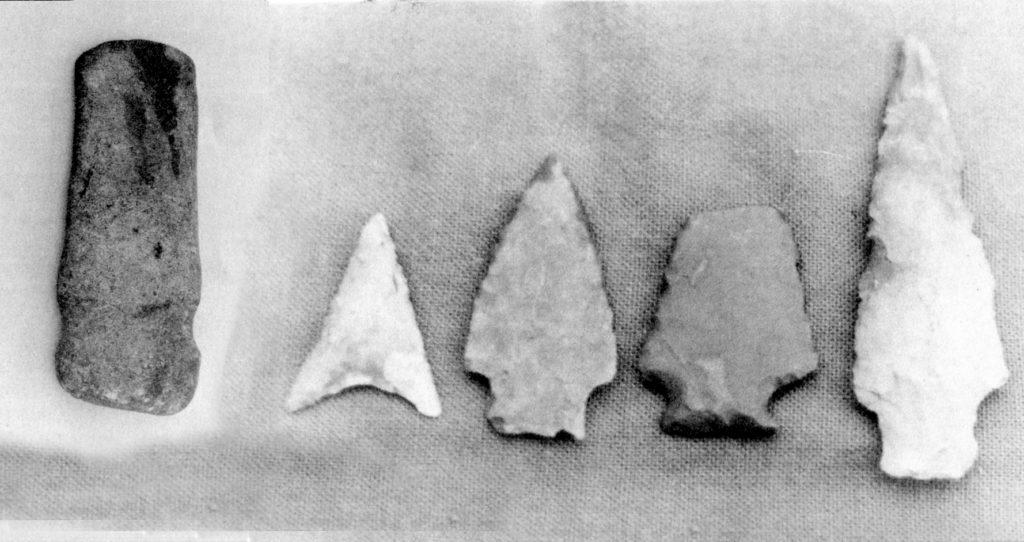By Al Shipley, City Historian and Rahway Library Research Consultant
Almost seven thousand years ago, when the banks of the Rahway River were decorated with picturesque foliage and the pure, still air was pierced only by the cries of wild game, man first set eyes on this area and sensed the possibilities of making it his home. The visitors at the time were members of the Lenni Lenape tribe (Len-ne Le-nah-pay), a group that had been migrating to New Jersey as early as 5000 B.C. It had taken their ancestors centuries to journey from Mongolia, across what is now the Bering Straits, through the northwestern part of North America, until they finally reached the Atlantic Ocean. They became the Indians of New Jersey who would call themselves “Men of Men” or “The Original People.” The history of their presence here is remembered in the name of the city.
Archaeological findings indicate that the largest Indian encampments were located in the western part of the state. Many Indians living in these settlements passed through the Rahway area as they followed what is today Westfield Avenue. This historic road was once a main Indian trail from the Watchung Mountains to the Arthur Kill. It was also the path that led to what is now St. Georges Avenue, a trail the Indians used as they traveled toward the southern regions. There is evidence that groups of these travelers made stops in this abundant territory and that some made encampments along the Rahway River during the summer months. The river afforded the Lenape the means to sustain their lives as they followed the primitive ways of the forest. The Indians found fish and game to be plentiful along the river and its banks. The river also served as an artery for transportation and one that could be easily handled by an Indian in a dugout canoe. Over the years, arrowheads used for hunting and fishing, axe heads, and grinding stones have been unearthed in several parts of the city.
This placid existence was maintained by the New Jersey Indians until the dawn of the 1500s when a new group of visitors discovered the region. It was at this time that the white man landed, bringing with him a culture that would eventually force the Lenape nation to change its way of life and ultimately vacate the region.
The Lenape’s first contact with Europeans is believed to have been in 1524 when they encountered the explorer Giovanni da Verrazzano when his ship entered Lower New York Bay. Over the next century and a half, interaction between the Lenape and the Europeans was primarily through the fur trade. Over the course of those years, the Europeans came to find the region to be extremely valuable, and permanent settlements were soon being established including Elizabethtown (1664) and Woodbridge (1669). It’s not certain how long the Indians remained in the vicinity, but most encampments were certainly abandoned by the 1670s when the four distinct villages in the area of present day Rahway were being settled. Once gone, the Indians would only be seen occasionally as they passed through on hunting excursions. In the Rahway area, the Indians and the new settlers were able to establish a tranquil relationship. Most of these early settlers were Quakers who, like the Indians, were a peace loving people. Both groups believed everyone should be treated fairly and took pride in their ability to live in harmony with one another.
After the arrival of the white man, the Lenni Lenape people were steadily moved back towards their larger camps in western Jersey which they inhabited until 1758 when they were moved to a reservation in Burlington County. They remained there until 1802, when they were forced to migrate into New York State and from New York, sent even farther west, retracing the steps of their forefathers.
Today, little remains of the rich tradition that was experienced by Rahway’s first “citizens.” Artifacts and legends are poignant reminders of Indian activities in the city, yet it is perhaps the name “Rahway” that is the most obvious. The term is derived from the name of a local Lenape chieftain called Wawhawahack, or Rahwack, or possibly Rahawa, which over many years evolved to its present form.
- Home
- Publications
- Berkeley Heights Community News
- Clark Monthly
- The Chathams
- Cranford Monthly
- East Hanover View
- Elmora Hills
- Fanwood Post
- Florham Park Press
- Garwood Times
- Green Brook Gazette
- Hanover Township Press
- Kenilworth Business Life
- Life in Linden
- Livingston Monthly
- Long Hill Leader
- Madison Monthly
- Millburn Short Hills Monthly
- Mountainside View
- Morristown Monthly
- Morris Township Times
- New Providence News
- Our Town Rahway
- Peterstown NJ
- Life in Roseland
- Roselle Park Monthly
- Scotch Plains Monthly
- Spirit of Union
- Summit Times
- Pride of North Plainfield
- Warren Monthly
- Watchung Post
- Westfield Monthly
- Articles
- Advertising Information
- About
- Submit News
- Photos

